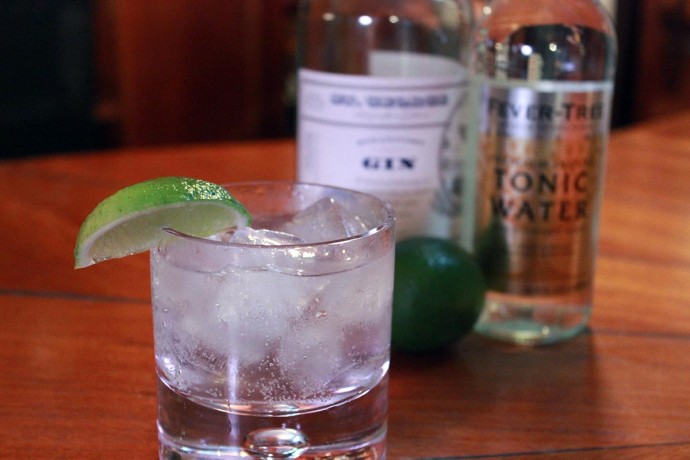Gin, tonic water, lime, and ice—while not the most complicated drink in the world by a long shot, the Gin and Tonic may well be one of the most historic. Aside from pioneering malaria prevention and serving as a health supplement for much of the last 300 years, it probably did as much to aid in the expansion of European colonialism as any gun or politician. And though much of that history is a black mark on Western history, it’s still an essential part of what has since become the most popular gin cocktail on Earth.
What is Tonic Water, Anyway?
The story starts in pre-colonial South America. For centuries, indigenous peoples in the region—most famously the Quechua of Peru and Bolivia—had used the bark of the cinchona tree as a remedy for fevers and various other ailments. Cinchona bark contains quinine, an alkaloid compound that just so happens to be very effective at treating and preventing malaria, and as soon as Spanish colonists learned of its medicinal value in the 17th century they began exporting it back to Europe.
As European powers expanded into other malaria-prone regions, the value of cinchona bark skyrocketed. Colonial governments and their militaries were only effective when they could keep the disease at bay, and over the course of the 18th and 19th centuries quinine became an essential part of their ability to operate around the world. By the early 1800s, chemists had figured out how to isolate quinine from cinchona bark, and used it to produce a medicinal tincture they dubbed tonic water.
This new medicine quickly became a household name in Europe, and due to its ability to break fevers in malaria patients, the cinchona tree came to be known as the “fever tree”—hence the name of today’s biggest craft tonic water brand.
Tonic water had its heyday in India in the 19th century, where British colonists—soldiers, bureaucrats, and civilian families alike—were provided with rations of “Indian tonic water” to stave off malaria. At the height of the British Raj, which lasted from 1858-1947, there were more than 150,000 Britons in India, almost all of whom consumed it daily (and that doesn’t even factor in the ranks of Indian nationals in the British armed forces).
Of course, it wasn’t long before the Brits started cutting their tonic rations with gin. Many, especially those in the Navy who were used to the citrus rations they were given to combat scurvy, added a bit of lime to their Gin and Tonics, and thus the classic cocktail was born.
How to Make a Gin and Tonic
The modern incarnation of the drink has quite a bit less quinine than the original would’ve had (less than a tenth of the amount needed for effective malaria prevention), but it retains the highly bitter flavor that makes it a great cocktail ingredient.
Unfortunately, most commercial tonic waters today include a whole bunch of sweeteners and high-fructose corn syrup, which have a tendency to overpower the other flavors in the drink. Luckily, though, there are a number of craft tonic waters that have come on the market in the last few years that stick to the basics.
The Gin
The beauty of a Gin and Tonic is its versatility. Any gin will impart its own unique characteristics to the drink, and with the bitterness of the tonic water as a unifying flavor, any blend of botanicals can add complexity to what would otherwise be a pretty simple drink.
The classic choices are good London dry gins, like Beefeater or Tanqueray, but you should feel free to experiment. Old Tom gins impart a unique sweetness, modern gins tend to be more citrus-forward, and there are all kinds of creative distillers in the US, UK, and elsewhere that are playing with other experimental flavor profiles. If you want to put a new brand through its paces, start with a G&T.
The Tonic
Tonic water is where things get a bit more complicated. Sure, you can use a Schweppes or Polar tonic water, and you’ll have yourself a decent drink—but you’ll also have more than 30 grams of sugar per 8-ounce serving, which is a bit egregious. More than being unhealthy (and let’s be honest, unless you’re in colonial India you’re not drinking this for your health), all that sweetness covers up the subtleties of your gin.
There are a bunch of great craft tonic syrups out there that you can choose from, but if you’re not exactly in a DIY sort of mood, new bottled options seem to be coming out every year. Fever-Tree is probably the most popular, but Q Tonic and Fentiman’s are also great brands that have pretty wide availability these days. If you’re anything like us, once you try one you’ll be snatching up every new bottle you can find.
The Lime
Limes are an integral part of a Gin and Tonic, as their citrusy bite cuts through the bitter tonic and juniper-heavy gin to give the drink a distinctive tang. Luckily, all you have to do is cut yourself a wedge, squeeze it into the drink, and drop it in. Who knew it was so easy to fight off scurvy?
Once you’ve got your drink make up in an Old-Fashioned glass (or Highball glass, depending on your preference), we recommend sitting back and ruminating on the centuries of history that went into it. While we’re certainly glad that modern malaria medications are fighting the disease more effectively than ever before, they’re nowhere near as easy on the palate.



